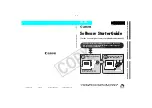
Optimizing Your Compaq COBOL Program
15.7 Optimizing File Design (OpenVMS)
A data level bucket may not be large enough to contain a new record. In this
case, the I/O system inserts a new bucket in the chain, moving enough records
from the old bucket to preserve the key value sequence. This is known as a
bucket split.
Data bucket splits can cause index bucket splits.
15.7.3.1 Optimizing Indexed File I/O
I/O optimization of an indexed file depends on five concepts:
•
Records—The size and format of the data records can affect the disk space
used by the file.
•
Keys—The number of keys and existence of duplicate key values can affect
disk space and processing time.
•
Buckets—Bucket size can affect disk space and processing time. Index depth
and file activity can affect bucket size.
•
Index depth—The depth of the index can affect bucket size and processing
time.
•
File size—The length of files affects space and access time.
Records
Variable-length records can save file space: you need write only the primary
record key data item (plus alternate keys, if any) for each record. In contrast,
fixed-length records require that all records be equal in length.
For example, assume that you are designing an employee master file. A variable-
length record file lets you write a long record for a senior employee with a large
amount of historical data, and a short record for a new employee with less
historical data.
In the following example of a variable-length record description, integer 10 of the
RECORD VARYING clause represents the length of the primary record key, while
integer 80 describes the length of the longest record in A-FILE:
FILE-CONTROL.
SELECT A-FILE ASSIGN TO "AMAST"
ORGANIZATION IS INDEXED.
DATA DIVISION.
FILE SECTION.
FD
A-FILE
ACCESS MODE IS DYNAMIC
RECORD KEY IS A-KEY
RECORD VARYING FROM 10 TO 80 CHARACTERS.
01
A-REC.
03
A-KEY
PIC X(10).
03
A-REST-OF-REC
PIC X(70).
.
.
.
Buckets must contain enough room for record insertion, or bucket splitting
occurs. The I/O system handles it by creating a new data bucket for the split,
moving some records from the original to the new bucket, and putting the pointer
to the new bucket into the lowest-level index bucket. If the lowest-level index
bucket overflows, the I/O system splits it in similar fashion, on up to the top level
(root level).
In an indexed file, the I/O system also maintains chains of forward pointers
through the buckets.
15–20 Optimizing Your Compaq COBOL Program
Содержание COBOL AAQ2G1FTK
Страница 22: ......
Страница 30: ......
Страница 94: ......
Страница 110: ......
Страница 146: ......
Страница 180: ......
Страница 194: ...Processing Files and Records 6 1 Defi...
Страница 300: ......
Страница 490: ......
Страница 516: ......
Страница 517: ......
Страница 530: ......
Страница 534: ......
Страница 590: ......
Страница 620: ......
















































